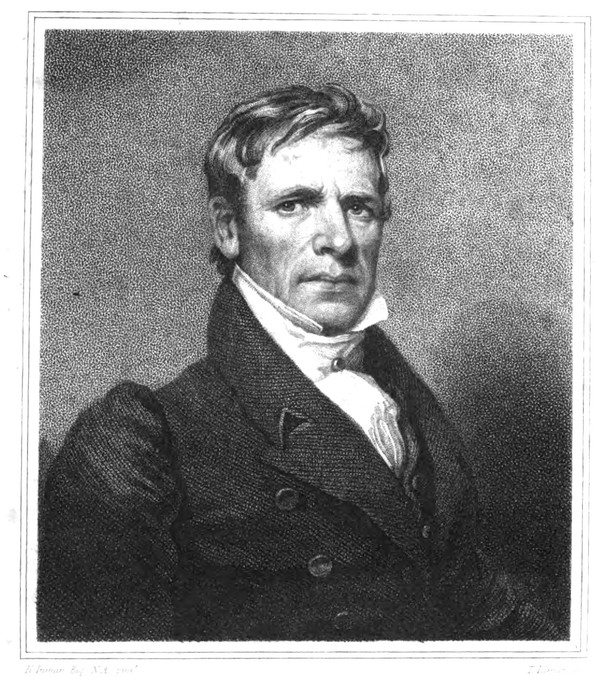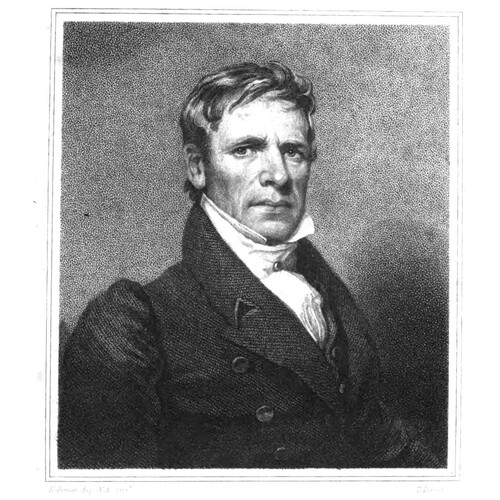
Source: Courtesy of Wikimedia Commons
TANNER, JOHN, hunter, guide, and narrator; b. c. 1780 along the Kentucky River, son of John Tanner; m. at least three times and had six or more children; d. in or after 1846.
John Tanner was the son of a former preacher from Virginia who had migrated to the Kentucky River country. After the boy’s mother died, when he was two, the family moved to Elk Horn (Elkhorn City, Ky), and later to the confluence of the Ohio and Great Miami rivers, where the elder Tanner homesteaded. There, in 1789, John was kidnapped by Shawnees. Named Shaw-shaw-wa-ne-ba-se, meaning “falcon,” he was later adopted by an Indian family. Shortly after his adoption he was sold to an old woman, Net-no-kwa, an Ottawa, and they moved first to Saginaw Bay (Mich.) and eventually, when Tanner was 13, to the Red River country (Man.), the home of Net-no-kwa’s husband, a Saulteaux.
In his Narrative Tanner gives a vivid account of the process of adaptation he underwent in learning to live in a culture so remote from that in which he had been brought up. He realized that, as a child, he stood no chance of escaping from the Indians, and at the same time he was aware of how inadequate he was in the skills necessary for survival among the Saulteaux, a nomadic Ojibwa people who followed an ancient life-style as trappers and hunters in the northern woodlands, but who also on occasion pursued bison on the prairie. By the time Tanner joined them that life-style was changing through contact with white traders, the re-orientation of subsistence hunting towards fur gathering for profit, and the introduction of firearms and alcohol. But the basic structure of society was still largely unchanged, and Tanner observed and recollected it in vivid detail, so that his Narrative offers a remarkable account of the material culture of this people, though he had little to say about their spiritual life. The great shamanic society of the Midewiwin is never mentioned, though its ceremonials with their complex initiations were the most important events of the tribal year. Was Tanner, white by origin, excluded from initiation? Or did he feel bound by initiation to remain silent? His Narrative gives no answer Tanner’s adoptive mother protected him from the brutal impatience of the Indian men, and eventually he became as skilled in trapping and hunting as his companions. For a long period he seems to have reconciled himself to Indian life. In his Narrative he contrasts the honesty of the Indians to the rapacity of the fur traders. He learned to speak the Indian languages and almost lost his own, to the point, he later remarked, where he “could not speak English so as to be at all understood.”
He first married in 1800 in the non-committal Indian manner, and when his wife, Mis-kwa-bun-o-kwa, left him some seven years later, he yielded to community pressure and remarried about 1810. He soon found the demands of his second wife’s family to be excessive. As a result, by 1812 he had begun to think of finding a way back to the life from which he had been snatched 20 years before. But the War of 1812 rendered travel impossible, and Tanner remained in the Red River country. When the settlers sent out by Lord Selkirk [Douglas*] arrived there in the summer of 1812, he hunted bison to give them winter food, and when Cuthbert Grant* of the North West Company tried to persuade the Indians to join him and his Métis followers in attacking the Hudson’s Bay Company men, Tanner refused to be drawn in on either side. Yet, after Selkirk’s men had captured Fort William (Thunder Bay, Ont.) in 1816, Tanner guided them from Lake of the Woods to Fort Douglas (Winnipeg) and helped them capture it from the Nor’Westers. After Selkirk arrived at Red River, he became interested in Tanner’s history, gave him a small pension, and sent out a letter in an effort to establish communication with his family in Kentucky.
Without waiting for an answer, Tanner left Lake of the Woods in 1817 and, travelling via Detroit where his brother had gone to meet him, rejoined his relatives. Returning to Lake of the Woods about 1818 for his family, he persuaded his second wife and their three children to travel with him the following spring, but she stayed at Michilimackinac (Mackinac Island, Mich.) and one of the children died on the way back to Kentucky. It was 1819 by the time Tanner had finished this journey. He had long since been spoiled for the routine life of a farming community. In 1823 he returned to the northwest to claim his children by his previous marriage, catching up with his first wife at Rainy Lake (Ont. ). She refused to surrender them, and persuaded an Indian to try to kill him by magic (shooting a bullet pierced by a deer sinew dyed green). Tanner survived under the care of Dr John McLoughlin*, but she vanished with the children.
Tanner made no further attempt to return to Kentucky. In 1824 he went to Michilimackinac where he worked as an interpreter for the American Indian agent and for 15 months as an employee of the American Fur Company. His second wife joined him temporarily but did not follow him when he moved in 1828 to Sault Ste Marie (Mich.), where he became an interpreter to the Indian agent there, Henry Rowe Schoolcraft. It was at about this time that Tanner met Edwin James, an American army surgeon, who patiently recorded his recollections and, along with a section of his own on Indian life and languages, had them published in New York in 1830. According to Schoolcraft, whose evidence may be biased, Tanner threatened James with violence for making him appear ridiculous, but in fact the Narrative seems to be an honestly rendered account of Tanner’s immersion in an alien culture.
By the 1830s Tanner, whom Schoolcraft had dismissed in 1830, was once again experiencing a culture shock: having found it hard to change into an Indian boy at 9, he was now finding it just as difficult to fit into an American community. He appears to have become involved in the hostility between Schoolcraft and the Reverend Abel Bingham over the control of the mission school at Sault Ste Marie. Probably in the early 1840s he married, and lost, a white woman who could not accept his life-style. Tanner impressed the people of Sault Ste Marie as an increasingly suspicious and paranoid man, violent in temper, and contemptuous of the way Christians practised their beliefs. The mutual resentment between the community and Tanner broke out in 1846 when James Schoolcraft, Henry’s brother, whom Tanner believed had defrauded him of money, was murdered. Tanner vanished at the same time, and immediately he was assumed to be guilty. He was never seen alive again, though a body found some years later in a bog near Sault Ste Marie was thought to be his; the identification was uncertain. So too was Tanner’s guilt, for suspicion also rested on an army officer, Lieutenant Bryant Tilden, who is said to have made a deathbed confession, but the evidence on neither side was conclusive.
John Tanner’s reminiscences were published as A narrative of the captivity and adventures of John Tanner, (U.S. interpreter at the Saut de Ste. Marie,) during thirty years residence among the Indians in the interior of North America, ed. Edwin James (New York, 1830; repr., intro. N. M. Loomis, Minneapolis, Minn., 1956). The work was subsequently translated into French and German. Tanner’s story was retold in an abridged version edited by James Macaulay, Grey Hawk: life and adventures among the Red Indians (London, 1883).
HBRS, 19 (Rich and Johnson). J. E. Bayliss et al., River of destiny, the Saint Marys (Detroit, 1955). J. T. Fierst, “Return to ‘civilization’: John Tanner’s troubled years at Sault Ste. Marie,” Minn. Hist. (St Paul), 50 (1986): 23–36. G. L. Nute, “Border chieftain,” Beaver, outfit 282 (March 1952): 35–39.
Cite This Article
George Woodcock, “TANNER, JOHN,” in Dictionary of Canadian Biography, vol. 7, University of Toronto/Université Laval, 2003–, accessed April 3, 2025, https://www.biographi.ca/en/bio/tanner_john_7E.html.
The citation above shows the format for footnotes and endnotes according to the Chicago manual of style (16th edition). Information to be used in other citation formats:
| Permalink: | https://www.biographi.ca/en/bio/tanner_john_7E.html |
| Author of Article: | George Woodcock |
| Title of Article: | TANNER, JOHN |
| Publication Name: | Dictionary of Canadian Biography, vol. 7 |
| Publisher: | University of Toronto/Université Laval |
| Year of revision: | 1988 |
| Access Date: | April 3, 2025 |



